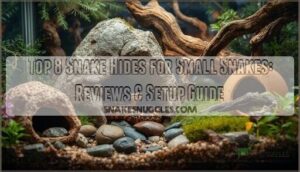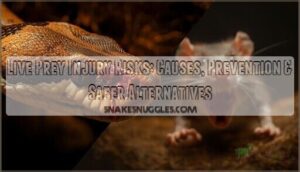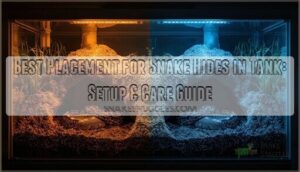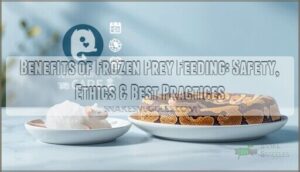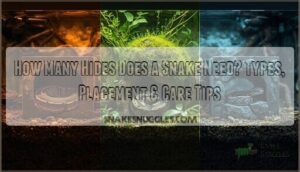This site is supported by our readers. We may earn a commission, at no cost to you, if you purchase through links.
Boa constrictors can live beyond 20 years in captivity, yet many die within their first five years due to preventable husbandry mistakes. These powerful constrictors demand precise temperature gradients, appropriately sized frozen prey, and enclosures that expand with their growth from hatchling to adult.
You’re not just purchasing a snake—you’re committing to decades of weekly maintenance, monthly deep cleans, and the financial investment of proper veterinary care.
Understanding subspecies differences matters too, since a red-tail boa’s temperament and size differ greatly from a boa imperator commonly sold in pet stores.
Getting boa constrictor pet care right from day one prevents respiratory infections, feeding refusal, and the stress-induced behaviors that signal inadequate conditions.
Table Of Contents
- Key Takeaways
- Choosing a Boa Constrictor as a Pet
- Setting Up The Ideal Boa Enclosure
- Temperature, Lighting, and Humidity Needs
- Feeding and Watering Your Boa Constrictor
- Handling, Health, and Common Care Issues
- Frequently Asked Questions (FAQs)
- What are common health issues in boa constrictors?
- How often should I clean the enclosure?
- What behavior indicates a sick boa constrictor?
- Are there specific veterinarians for boa constrictors?
- Can boa constrictors coexist with other pets?
- Can boa constrictors be housed together safely?
- How much does a boa constrictor cost?
- Are boa constrictors legal to own everywhere?
- Do boa constrictors require UVB lighting?
- Conclusion
Key Takeaways
- Boa constrictors demand decades-long commitment with precise environmental controls—temperature gradients of 75-90°F, 50-70% humidity, and enclosures expanding from 61cm for neonates to 180cm+ for adults—where husbandry mistakes cause most early deaths.
- Subspecies selection matters significantly since Boa imperator differs from red-tail boas in temperament and size, while individual personality traits remain stable from juvenile to adult stages regardless of consistent handling.
- Feeding protocols prevent the leading cause of captive mortality by maintaining proper prey size at 8-15% body weight, avoiding handling for 48 hours post-feeding, and adjusting intervals from 10-12 days for juveniles to 4-8 weeks for adults.
- Early disease detection through biannual fecal exams, 60-90 day quarantine protocols, and recognizing clinical signs like respiratory distress or persistent anorexia prevents progression of viral infections, parasitic infestations, and husbandry-related disorders that remain hidden until late stages.
Choosing a Boa Constrictor as a Pet
Before you bring a boa constrictor home, you need to understand what you’re getting into. These snakes aren’t a one-size-fits-all pet—different subspecies come with their own quirks, care needs, and space requirements.
Let’s break down what makes boas unique and whether one might be the right fit for your situation.
Common Boa Constrictor Species and Subspecies
The Boa constrictor family includes eight recognized subspecies, each with distinct origins and appearances.
Boa imperator, historically from Central America, dominates the pet market due to widespread captive breeding. Red-tail boas (Boa constrictor constrictor) from South America display vivid tail blotches.
Argentine boa (Boa constrictor occidentalis) faces trade restrictions, while Amarali boas and island subspecies remain less common but prized by specialized collectors.
Temperament and Behavior Traits
Beyond species differences, individual Boa constrictor temperament varies considerably. Research on 75 captive boas identified stable personality axes—feeding motivation and agonistic behavior—that persist from juvenile to adult stages. You’ll notice some boas remain naturally bold explorers while others stay defensive. Nocturnal animal behavior means your snake will be most active at night.
Boa constrictor personalities vary from bold explorers to defensive homebodies, with stable traits that persist from youth to adulthood
Key Boa constrictor behavior patterns include:
- Handling Response: Captive-bred specimens become docile with regular 5–10 minute sessions
- Activity Patterns: Primarily nocturnal, resting during daylight hours
- Stress Indicators: Tight coiling, escape attempts, and feeding refusal signal problems
- Cognitive Abilities: Boas adjust constriction pressure based on prey heartbeat feedback
Snake temperament reflects both genetics and early handling. Docility influence from consistent, gentle interaction transforms most boas into calm pets, though wild-caught animals often retain defensive snake behavior like hissing and striking.
Size and Lifespan Expectations
Understanding your snake’s growth trajectory matters when you’re planning for decades ahead. Most Boa constrictor adults reach 5–8 feet within six years, though Sexual Dimorphism means females often hit 10 feet while males stay closer to 6.
Growth Rate slows after maturity, but Captive Longevity of 20–30 years—occasionally reaching 40—means you’ll watch juveniles transform into impressive, long-lived companions.
Assessing Care Difficulty and Commitment
That impressive lifespan comes with real responsibilities—weekly spot-cleaning, monthly deep maintenance, and daily environmental checks add up fast.
Financial burden starts around $1,000 for a quality adult enclosure, plus roughly $200 yearly for frozen prey.
Handling risks stay low with proper technique, but veterinary needs and lifestyle impact mean you’re committing decades to consistent boa constrictor care and health monitoring.
Setting Up The Ideal Boa Enclosure
Your boa constrictor’s enclosure isn’t just a cage—it’s the foundation of their health and behavior. Getting the setup right from the start prevents stress, illness, and escape attempts down the line.
Here’s what you need to know about sizing, security, enrichment, and maintaining a clean habitat.
Recommended Enclosure Size by Age
Your snake’s home must grow with it—choosing the right enclosure size at every life stage prevents stress and fosters healthy behavior.
Neonate enclosure needs start small, then juvenile space requirements expand, followed by subadult cage upgrades, until you reach adult size enclosures or oversized boa habitats:
- Neonates (0–6 months): 61 cm × 46 cm × 30 cm provides adequate floor space for appropriately sized habitat setup
- Juveniles (6–18 months): 120 cm × 60 cm × 60 cm accommodates rapid growth
- Subadults (18–36 months): 150 cm × 75 cm × 75 cm transitions toward adult dimensions
- Adults (≥3 years): 180 cm × 90 cm × 90 cm minimum; larger females may require 240 cm × 120 cm × 120 cm
Escape-Proofing and Security Measures
How do you keep a powerful, curious snake inside its home? Start with rigid enclosure materials—PVC or impact-resistant HDPE—rather than glass aquariums with flimsy screen tops. Install locking mechanisms on every door, and seal gaps smaller than your boa’s head diameter. Maintain secondary containment by securing room exits.
Most escapes trace back to human error: doors left ajar or latches forgotten.
Hide Boxes, Climbing Branches, and Decor
Beyond bare walls, your boa constrictor habitat thrives on strategic complexity. Provide two identical hide boxes—each just wide enough for your snake’s coiled body—at opposite thermal zones. Add sturdy climbing decor: branches thick enough to support full body weight without flexing.
Layer artificial foliage to break sightlines and create visual barriers. A heavy water dish is essential, as boas need accessible fresh water for soaking and hydration.
Introduce texture variety with sphagnum moss pockets and leaf litter over substrate, building distinct microhabitats that encourage natural exploration and reduce stress.
Substrate Options and Cleaning Practices
Your boa’s foundation deserves attention—substrate depth of 3–4 inches allows proper waste absorption and humidity impact while supporting light burrowing. Moisture-retentive cypress mulch outperforms aspen for humidity stability. Paper substrates work for quarantine but demand more frequent misting than particulate snake substrate options.
Spot cleaning removes feces daily; deep cleaning every 3–6 months with veterinary-grade disinfectants like F10SC (1:250 dilution) ensures disinfectant safety.
Boa constrictors benefit from proper UVB lighting for prime health.
Temperature, Lighting, and Humidity Needs
Creating the right thermal environment is non-negotiable for your boa’s health and digestion. You’ll need to establish specific temperature zones, maintain proper humidity, and choose heat sources that won’t compromise safety.
Let’s break down each element so you can dial in the conditions your snake needs to thrive.
Establishing a Temperature Gradient
Creating a proper temperature gradient transforms your enclosure into a physiological toolkit your boa constrictor uses to regulate metabolism, digestion, and overall health. Position your heat source on one side to establish distinct thermal zones that allow natural thermoregulation.
- Hot zone: Maintain 86-90°F air temperature with basking surface temps reaching 4-5°F higher
- Cool zone importance: Keep the opposite end at 75-80°F for thermal retreat
- Nighttime temperature drops: Allow cooling to 68-75°F by turning off daytime heating
Basking Spot Requirements
Your basking spot’s surface temperature should reach 90-95°F—think of it as your boa’s solar charging station. Use ceramic heat emitters or halogen bulbs as heat sources, always controlled by a calibrated thermostat to prevent dangerous spikes.
Measure surface temps with an infrared gun, not just air readings. Most boas will bask 2-4 hours daily before retreating along the temperature gradient. Allow a nighttime drop to 75-80°F.
Humidity Levels and Maintenance
Just as important as warmth, humidity levels between 50–70% safeguard respiratory health and prevent shedding problems. Place your digital hygrometer mid-height—not floor or ceiling—for the most accurate readings.
Misting frequency depends on substrate choice: moisture-retentive bedding holds humidity longer than paper. Boost levels to 70–80% during sheds by adding a sphagnum moss hide, checking daily to stay within your boa’s ideal humidity range.
Lighting Choices and Heat Source Safety
White incandescent bulbs or halogen floods deliver broad basking spot heat matching your boa’s coiled body, while UVB lighting at Ferguson Zone 2 (UVI 2.0–3.0) promotes natural rhythms. Position ShadeDweller fixtures 4–6 inches above mesh or T5 HO tubes 10–14 inches away.
Always plug heat sources into thermostats to prevent burn injuries, cage bulbs inside the enclosure, and inspect wiring monthly for fire safety.
Feeding and Watering Your Boa Constrictor
Your boa constrictor’s diet isn’t complicated, but getting it right makes all the difference between a thriving snake and one that struggles with health problems. You’ll need to understand what prey to offer, how often to feed, and which practices prevent regurgitation and stress during feeding time.
Let’s cover the essential feeding and watering guidelines that keep your boa healthy for decades.
Prey Types and Feeding Frequency
How often should you feed your boa constrictor? The answer depends on age, metabolism, and season. Younger boas grow rapidly and require more frequent meals—every 10–12 days for neonates—while adults maintained at a stable weight thrive on intervals of 4–8 weeks. A proper boa constrictor feeding schedule prevents overfeeding risks such as obesity and hepatic lipidosis.
Frozen vs. Live Prey Considerations:
- Frozen-thawed rodents eliminate injury risk from defensive bites and reduce parasite exposure
- Prey variety can include mice, rats, young rabbits, or small birds like chicks
- Seasonal feeding adjustments match winter cooling with longer intervals—sometimes 70–90 days
Proper Prey Size and Thawing Frozen Food
Getting prey size right is critical: offer rodents weighing 8–15% of your boa’s body mass, with the prey diameter equal to or slightly smaller than your snake’s widest point.
Thaw frozen rodents in a refrigerator for 4–12 hours, then warm them in water to about 96°F—never microwave, which causes uneven heating. Discard thawed prey left out more than two hours to prevent bacterial growth and illness.
Safe Feeding Practices and Preventing Regurgitation
To minimize regurgitation risk—the leading cause of death in young captive boas—wait 10 to 14 days between feedings for juveniles and 14 to 21 days for adults. Never handle your boa for 48 hours post-feeding; disturbance triggers premature expulsion.
Maintain enclosure temperatures between 82–90°F, as inadequate warmth slows digestion.
Use only fresh, properly thawed prey to prevent bacterial upset.
Water Bowl Placement and Hydration
Position your water dish away from the basking zone within the thermal gradient to prevent overheating and bacterial overgrowth. A heavy, stable bowl large enough for full-body soaking aids humidity control in the ideal humidity range of 50–70% and encourages natural drinking behavior.
Daily bowl hygiene prevents pathogen exposure. Watch for clinical signs of dehydration—wrinkled skin, sunken eyes, or tacky mouth—that signal inadequate water access in your boa constrictor care guide.
Handling, Health, and Common Care Issues
Keeping your boa constrictor healthy starts with knowing how to handle it safely and recognizing when something’s off. Regular interaction helps your snake stay calm and manageable, but you’ll also need to watch for signs of illness and understand normal behaviors like shedding.
Let’s walk through the handling basics, health indicators, and common problems you might encounter so you can keep your boa in top shape.
Safe Handling Techniques and Taming
Proper Boa constrictor handling begins with patience—wait 2 to 8 weeks after relocation until your snake feeds reliably, then handle 1 to 2 times per week. Always support the body at multiple points to distribute weight, lift from the midbody rather than the tail, and approach from the side to minimize defensive strikes.
| Handling Element | Recommended Practice | Why It Matters |
|---|---|---|
| Handling frequency | 1–2 times weekly once feeding | Maintains habituation without chronic stress |
| Body support | Two hands, multiple contact points | Prevents vertebral strain and struggling |
| Hook usage | Tap front third before opening door | Distinguishes handling from feeding, reduces bite risk |
Temperament conditioning improves with gentle, consistent sessions starting at 5 to 10 minutes. Use snake handling techniques like allowing your boa to move through your hands rather than restraining it tightly—this lowers stress and builds trust. For snakes over 8 feet, always have a second handler present to manage bite risk safely.
Wash hands beforehand to remove prey odors, and never handle within 24 to 48 hours after feeding to prevent regurgitation. Taming takes time, but stability in your enclosure and routine transforms defensive juveniles into calm, puppy-dog-tame adults. Preventing Boa constrictor bites is largely about reading body language: tight coiling, rapid tongue flicking, and an elevated head signal it’s not the right moment.
Signs of Good Health and Shedding
A healthy boa constrictor shows muscle tone without prominent ribs, clear eyes free of discharge, and frequent tongue flicking during exploration. Intact skin with no blisters or scabs signals good integumentary health, while a relaxed demeanor—supporting its own weight when climbing—reflects strong neuromuscular status.
Proper shedding occurs every 4–8 weeks in juveniles, completing in one piece when humidity stays between 55–75%, rising to 75–85% during the shed cycle.
Preventing and Identifying Illnesses
Vigilant husbandry is your first line of defense against common illnesses in boa constrictors. Quarantine protocols lasting 60–90 days screen new acquisitions for reptarenaviruses and nidoviruses, which cause fatal viral diseases and respiratory infections respectively.
Your preventive care checklist should include:
- Fecal exams twice yearly to detect parasitic infestations early
- Temperature and humidity precision to prevent husbandry disorders
- Regular weight tracking to identify wasting before clinical signs appear
When to Seek Veterinary Care
Early intervention is crucial when addressing health issues in boa constrictors, as it can significantly impact treatment outcomes. If your boa exhibits any of the following symptoms, seek immediate veterinary care: respiratory distress (open-mouth breathing, wheezing), persistent anorexia or weight loss, neurologic signs like poor coordination, traumatic injuries, or general red flags such as abnormal discharge or skin lesions.
| Emergency Sign | What to Watch For |
|---|---|
| Respiratory distress | Gaping mouth, wheezing, nasal discharge |
| Anorexia/Weight loss | Weeks without eating, visible spine |
| Neurologic signs | Tremors, inability to right itself |
| Traumatic injuries | Wounds, burns, cloacal prolapse |
Boa constrictors’ health can deteriorate rapidly without prompt treatment. Even subtle changes warrant professional assessment, as common illnesses in these snakes often remain hidden until the late stages. Establishing care with an experienced reptile veterinarian before emergencies arise ensures your snake receives appropriate diagnostics and treatment when time is critical.
Frequently Asked Questions (FAQs)
What are common health issues in boa constrictors?
Regarding snake health problems, don’t let issues slip through the scales. Respiratory infections, inclusion body disease, parasitic infestations, digestive disorders, and skin conditions represent the most common boa constrictor health issues you’ll encounter.
How often should I clean the enclosure?
You’ll want to spot-clean your snake enclosure daily, removing waste and checking water bowls immediately.
Deep cleaning with proper disinfectant choices and complete substrate management should happen every one to three months.
What behavior indicates a sick boa constrictor?
Lethargy signs, persistent open-mouth breathing, appetite changes lasting weeks, unusual posture, repeated regurgitation, skin issues like incomplete shedding, or excessive water bowl soaking indicate reptile health problems requiring veterinary care for proper snake disease diagnosis.
Are there specific veterinarians for boa constrictors?
Finding a “boa specialist” might feel like hunting for a needle in a haystack—most reptile vets treat multiple exotic species.
Only 3–5% of U.S. practices focus on exotics, making geographic limitations real.
Can boa constrictors coexist with other pets?
Boa constrictors shouldn’t coexist with other pets due to predator instincts and pet safety risks. Even in captivity, their feeding behavior poses serious household dynamics challenges.
Secure snake care requires complete separation during handling and feeding routines.
Can boa constrictors be housed together safely?
Housing two boas together isn’t recommended. Cohabitation risks include dominance stress, feeding injuries, and disease transmission in captivity. Even oversized enclosure setups can’t eliminate conflict.
Breeding practices may pair snakes briefly, but separate snake housing protects your snake’s welfare.
How much does a boa constrictor cost?
Your initial investment generally runs $50 to $150 for normal morphs, though rare variants reach $15, Setup expenses span $543 to $4,000, with monthly upkeep averaging $100 for food, substrate, and veterinary fees combined.
Are boa constrictors legal to own everywhere?
No, boa constrictor ownership laws vary by location. Federal vs. State regulations differ, with some areas imposing permit requirements or banning them as invasive concerns.
Always verify local rules before acquiring a pet snake to avoid legal issues.
Do boa constrictors require UVB lighting?
While your boa constrictor won’t die without UVB benefits, providing low-level UV light enhances D3 synthesis, immune function, and activity—mirroring wild behavior.
Proper lighting setup, with safety concerns addressed, optimizes long-term snake lighting health and vitality.
Conclusion
Your boa’s first respiratory infection, missed feeding, or escape attempt will teach you what decades of reading can’t—that prevention beats intervention every time.
Mastering boa constrictor pet care means catching subtle temperature drops before pneumonia develops, recognizing stress signals before feeding refusal begins, and understanding that your snake’s health hinges on consistency, not guesswork.
The snakes that thrive for twenty years don’t belong to lucky owners—they belong to prepared ones.
- https://www.snakehaus.com/frontpage/education/enclosures-2/hides/
- https://repository.lincoln.ac.uk/articles/journal_contribution/Does_the_provision_of_environmental_enrichment_affect_the_behaviour_and_welfare_of_captive_snakes_/24391486
- https://reptifiles.com/boa-constrictor-care/boa-constrictor-decor/
- https://animal-pedia.org/snakes/boa-snake/
- https://www.knobcreeknaturalist.com/blog/boa-constrictor-enclosure-decor









